Construction and Optimization of Urban and Rural Ecological Security Patterns Based on Ecological Service Importance in a Semi-Arid Region: A Case Study of Lanzhou City
Abstract
:1. Introduction
2. Materials and Methods
2.1. Overview of the Research Area
2.2. Data Sources
2.3. Research Framework
2.4. Research Methods
2.4.1. Water Yield
2.4.2. Soil Conservation
2.4.3. Habitat Quality
2.4.4. Construction of Ecological Source Area and Resistance Surface
2.4.5. MCR Minimum Resistance Surface Model
2.4.6. Circuit Theory
2.4.7. Space Syntax
2.4.8. Artificial Neural Network (ANN)
3. Results
3.1. Ecosystem Service Function Evaluation
3.2. Evaluation and Classification of Ecosystem Service Importance
3.3. Optimization of Ecological Source Area
3.4. Construction of Ecological Resistance Surface
3.5. Construction and Optimization of Ecological Security Pattern
3.5.1. MCR Ecological Corridor
3.5.2. Circuit Model Corridor
3.5.3. Space Syntax Analysis
3.5.4. Neural Network Analysis
3.5.5. Importance Analysis of Influence Factors
4. Discussion
4.1. Optimization of Ecological Security Pattern Identification Framework
4.2. The Role of Ecological Security Patterns in Spatial Planning
4.3. Deficiencies of Ecological Security Pattern Construction
5. Conclusions
Author Contributions
Funding
Institutional Review Board Statement
Informed Consent Statement
Data Availability Statement
Acknowledgments
Conflicts of Interest
References
- Chau, P.H.; Chan, K.C.; Woo, J. Hot weather warning might help to reduce elderly mortality in Hong Kong. Int. J. Biometeorol. 2009, 53, 461–468. [Google Scholar] [CrossRef] [PubMed]
- Chen, J.; Wang, S.; Zou, Y. Construction of an ecological security pattern based on ecosystem sensitivity and the importance of ecological services: A case study of the Guanzhong Plain urban agglomeration. China Ecol. Indic. 2022, 136, 108688. [Google Scholar] [CrossRef]
- Chen, L.; Sun, R.; Sun, T.; Yang, L. Construction of ecological security pattern in urban agglomerations: Conceptual analysis and theoretical consideration. Acta Ecol. Sin. 2021, 41, 4251–4258. [Google Scholar]
- Ouyang, X.; Tang, L.; Wei, X.; Li, Y. Spatial interaction between urbanization and ecosystem services in Chinese urban agglomerations. Land Use Policy 2021, 109, 105587. [Google Scholar] [CrossRef]
- Chen, M.; Liu, W.; Lu, D. Challenges and the way forward in China’s new-type urbanization. Land Use Policy 2016, 55, 334–339. [Google Scholar] [CrossRef]
- Bongaarts, J. IPBES, 2019. Summary for policymakers of the global assessment report on biodiversity and ecosystem services of the Intergovernmental Science-Policy Platform on Biodiversity and Ecosystem Services. Popul. Dev. Rev. 2019, 45, 680–681. [Google Scholar] [CrossRef]
- Maron, M.; Mitchell, M.G.; Runting, R.K.; Rhodes, J.R.; Mace, G.M.; Keith, D.A.; Watson, J.E. Towards a Threat Assessment Framework for Ecosystem Services. Trends Ecol. Evol. 2017, 32, 240–248. [Google Scholar] [CrossRef] [PubMed]
- Ma, L.; Bo, J.; Li, X.; Fang, F.; Cheng, W. Identifying key landscape pattern indices influencing the ecological security of inland river basin: The middle and lower reaches of Shule River Basin as an example. Sci. Total Environ. 2019, 674, 424–438. [Google Scholar] [CrossRef]
- Kukkala, A.S.; Moilanen, A. Ecosystem services and connectivity in spatial conservation prioritization. Landsc. Ecol. 2016, 32, 5–14. [Google Scholar] [CrossRef]
- Fu, B.; Liu, Y. The theories and methods for systematically understanding land resource. Chin. Sci. Bull. 2019, 21, 2172–2179. [Google Scholar]
- Yu, K. Security patterns and surface model in landscape ecological planning. Landsc. Urban Plan. 1996, 4, 1–17. [Google Scholar] [CrossRef]
- Fu, B. Several Key Points in Territorial Ecological Restoration. Bull Chin. Acad. Sci. 2021, 36, 64–69. [Google Scholar]
- Dai, L.; Liu, Y.; Luo, X. Integrating the MCR and DOI models to construct an ecological security network for the urban agglomeration around Poyang Lake, China. Sci. Total Environ. 2021, 754, 141868. [Google Scholar] [CrossRef] [PubMed]
- Xiong, S.; Qin, C.; Yu, L.; Lu, L.; Guan, Y.; Wan, J.; Li, X. Methods to identify the boundary of ecological space based on ecosystem service functions and ecological sensitivity: A case study of Nanning city. Acta Ecol. Sin. 2018, 38, 7899–7911. [Google Scholar]
- Dong, J.; Peng, J.; Xu, Z.; Liu, Y.; Wang, X.; Li, B. Integrating regional and interregional approaches to identify ecological security patterns. Landsc. Ecol. 2021, 4, 2151–2164. [Google Scholar] [CrossRef]
- Gao, Q.; Fang, C.; Liu, H.; Zhang, L. Conjugate evaluation of sustainable carrying capacity of urban agglomeration and multi-scenario policy regulation. Sci. Total Environ. 2021, 785, 147373. [Google Scholar] [CrossRef] [PubMed]
- Huang, Q.; Peng, B.; Elahi, E.; Wan, A. Evolution and Driving Mechanism of Ecological Security Pattern: A Case Study of Yangtze River Urban Agglomeration. Integr. Environ. Assess. Manag. 2021, 17, 573–583. [Google Scholar] [CrossRef] [PubMed]
- Fang, C.; Yu, D. Urban agglomeration: An evolving concept of an emerging phenomenon. Landsc. Urban Plan. 2017, 162, 126–136. [Google Scholar] [CrossRef]
- Li, X.; Li, S.; Zhang, Y.; O’Connor, P.J.; Zhang, L.; Yan, J. Landscape Ecological Risk Assessment under Multiple Indicators. Land 2021, 10, 739. [Google Scholar] [CrossRef]
- Marlatt, W.E.; Budyko, M.I.; Miller, D.H. Climate and life. J. Range Manag. 1975, 28, 160. [Google Scholar] [CrossRef]
- Lu, L.; Ren, T.; Li, S.; Han, Y. Analysis on Spatio-temporal Variation of Water Supply in Dalian City Based on InVEST Model. Bull Soil Water Conserv. 2019, 39, 144–150. [Google Scholar]
- Dou, M. Spatio-Temporal Variation of Water Production Function and its Influencing Factors in Hengduan Mountain Region Based on InVEST Model. Ph.D. Thesis, Lanzhou Jiaotong University, Gansu, China, 2018. [Google Scholar]
- Wischmeier, W.H.; Smith, D.D. Predicting Rainfall-Erosion Losses from Cropland East of the Rocky Mountains; Department of Agriculture: Washington, DC, USA, 1965.
- Williams, J.R. The erosion-productivity impact calculator (EPIC) model: A case history. Philos. Trans. R. Soc. London. Ser. B Biol. Sci. 1990, 329, 421–428. [Google Scholar] [CrossRef]
- Zhang, K.L.; Shu, A.P.; Xu, X.L.; Yang, Q.K.; Yu, B. Soil erodibility and its estimation for agricultural soils in China. J. Arid Environ. Regul. 2008, 72, 1002–1011. [Google Scholar] [CrossRef]
- Zhang, Y.; Yuan, J.; Liu, B. Advance in researches on vegetation cover and management factor in the soil erosion prediction model. Ying Yong Sheng Tai Xue Bao J. Appl. Ecol. 2002, 13, 1033–1036. [Google Scholar]
- Yang, Z. Study on Soil Loss Equation of Cultivated Slopeland in Northeast Mountain Region of Yunnan Province. Bull. Soil Water Conserv. 1999, 19, 1–9. [Google Scholar]
- Liu, Q.; Zhao, Y.; Zhang, X.; Buyantuev, A.; Niu, J.; Wang, X. Spatiotemporal Patterns of Desertification Dynamics and Desertification Effects on Ecosystem Services in the Mu Us Desert in China. Sustainability 2018, 10, 589. [Google Scholar] [CrossRef]
- Xie, Y. Temporal and Spatial Changes of Ecosystem Services in Bailong River Basin, Gansu Province based on InVEST Model; Lanzhou University: Gansu, China, 2015. [Google Scholar]
- Xu, B.; Liu, Y.; Dong, Y.; Zhu, G.; Zhang, Y.; Lu, Z.; Zou, S. Habitat quality assessment in Lanzhou area based on InVEST model. J. Desert Res. 2019, 41, 120–129. [Google Scholar]
- Knaapen, J.P.; Scheffer, M.; Harms, B. Estimating habitat isolation in landscape planning. Landsc. Urban Plan. 1992, 23, 1–16. [Google Scholar] [CrossRef]
- Huang, L.; Wang, J.; Fang, Y.; Zhai, T.; Cheng, H. An integrated approach towards spatial identification of restored and conserved priority areas of ecological network for implementation planning in metropolitan region. Sustain. Cities Soc. 2021, 69, 102865. [Google Scholar] [CrossRef]
- McRae, B.H.; Dickson, B.G.; Keitt, T.H.; Shah, V.B. Using circuit theory to model connectivity in ecology, evolution, and conservation. Ecology 2008, 89, 2712–2724. [Google Scholar] [CrossRef]
- Peng, J.; Yang, Y.; Liu, Y.; Du, Y.; Meersmans, J.; Qiu, S. Linking ecosystem services and circuit theory to identify ecological security patterns. Sci. Total Environ. 2018, 644, 781–790. [Google Scholar] [CrossRef] [PubMed]
- Brede, M. Networks—An Introduction; Newman, M.E.J., Ed.; Oxford University Press: Oxford, UK, 2012; 772p, ISBN-978-0-19-920665-0. [Google Scholar]
- Patuelli, R.; Reggiani, A.; Nijkamp, P.; Schanne, N. Neural networks for regional employment forecasts: Are the parameters relevant? J. Geogr. Syst. 2011, 13, 67–85. [Google Scholar] [CrossRef]
- Hooper, T.; Beaumont, N.; Griffiths, C.; Langmead, O.; Somerfield, P.J. Assessing the sensitivity of ecosystem services to changing pressures. Ecosyst. Serv. 2017, 24, 160–169. [Google Scholar] [CrossRef]
- Rao, Y.; Dai, J.; Dai, D.; He, Q.; Wang, H. Effect of Compactness of Urban Growth on Regional Landscape Ecological Security. Land 2021, 10, 848. [Google Scholar] [CrossRef]
- Peng, J.; Zhao, H.J.; Liu, Y.X.; Wu, J.S. Research progress and prospect on regional ecological security pattern construction. Geogr. Res. 2017, 4, 407–419. [Google Scholar]
- Peng, J.; Liu, Y.; Corstanje, R.; Meersmans, J. Promoting sustainable landscape pattern for landscape sustainability. Landsc. Ecol. 2021, 36, 1839–1844. [Google Scholar] [CrossRef]
- Patten, D.T. The role of ecological wisdom in managing for sustainable interdependent urban and natural ecosystems. Landsc. Urban Plan. 2016, 155, 3–10. [Google Scholar] [CrossRef]
- Pena, S.B.; Abreu, M.M.; Teles, R.; Espírito-Santo, M.D. A methodology for creating greenways through multidisciplinary sustainable landscape planning. J. Environ. Manag. 2010, 91, 970–983. [Google Scholar] [CrossRef] [PubMed]
- Teng, M.; Wu, C.; Zhou, Z.; Lord, E.; Zheng, Z. Multipurpose greenway planning for changing cities: A framework integrating priorities and a least-cost path model. Landsc. Urban Plan. 2011, 103, 1–14. [Google Scholar] [CrossRef]
- Chuanglin, F. Construction of urban agglomerations and metropolitan areas in China under the new development pattern. Econ. Geogr. 2021, 41, 1–7. [Google Scholar]
- Zhu, Y.G.; Reid, B.J.; Meharg, A.A.; Banwart, S.A.; Fu, B.J. Optimizing Peri-URban Ecosystems (PURE) to re-couple urban-rural symbiosis. Sci. Total Environ. 2017, 586, 1085–1090. [Google Scholar] [CrossRef] [PubMed]
- Ren, Y.; Fang, C.; Lin, X.; Sun, S.; Li, G.; Fan, B. Evaluation of the eco-efficiency of four major urban agglomerations in coastal eastern China. J. Geogr. Sci. 2019, 29, 1315–1330. [Google Scholar] [CrossRef]
- Yang, Y.; Cai, Z. Ecological security assessment of the Guanzhong Plain urban agglomeration based on an adapted ecological footprint model. J. Clean. Prod. 2019, 260, 120973. [Google Scholar] [CrossRef]
- Baro, F.; Gomez-Baggethun, E.; Haase, D. Ecosystem service bundles along the urban-rural gradient: Insights for landscape planning and management. Ecosyst. Serv. 2017, 24, 147–159. [Google Scholar] [CrossRef]
- Chuanglin, F.; Xuegang, C.; Longwu, L. Coupling loop theory and coupler regulation between urbanization and ecological environment. Acta Geogr. Sin. 2019, 74, 2529–2546. [Google Scholar]
- Bojie, F.; Hanqin, T.; Fulu, T.; Zhao, W.W.; Wang, S. Progress of the impact of global change on ecosystem services. Basic Sci. China 2019, 22, 25–30. [Google Scholar]
- Fang, C. The basic law of the formation and expansion in urban agglomerations. J. Geogr. Sci. 2019, 29, 1699–1712. [Google Scholar] [CrossRef]
- Yaoyao, C.; Zhijun, L.; Song, Q. Construction of ecological security pattern based on ecological sensitivity and ecological network in Nanchang City. Res. Soil Water Conserv. 2021, 28, 342–349. [Google Scholar]
- Zhang, L.Z.; Qing, A.L.; Cui, M.Y.; Zeng, W.X. Between the In-between: A Design Study of “Cool Network” Based on 3D Accessibility. J. Landsc. Archit. 2022, 29, 109–114. [Google Scholar]

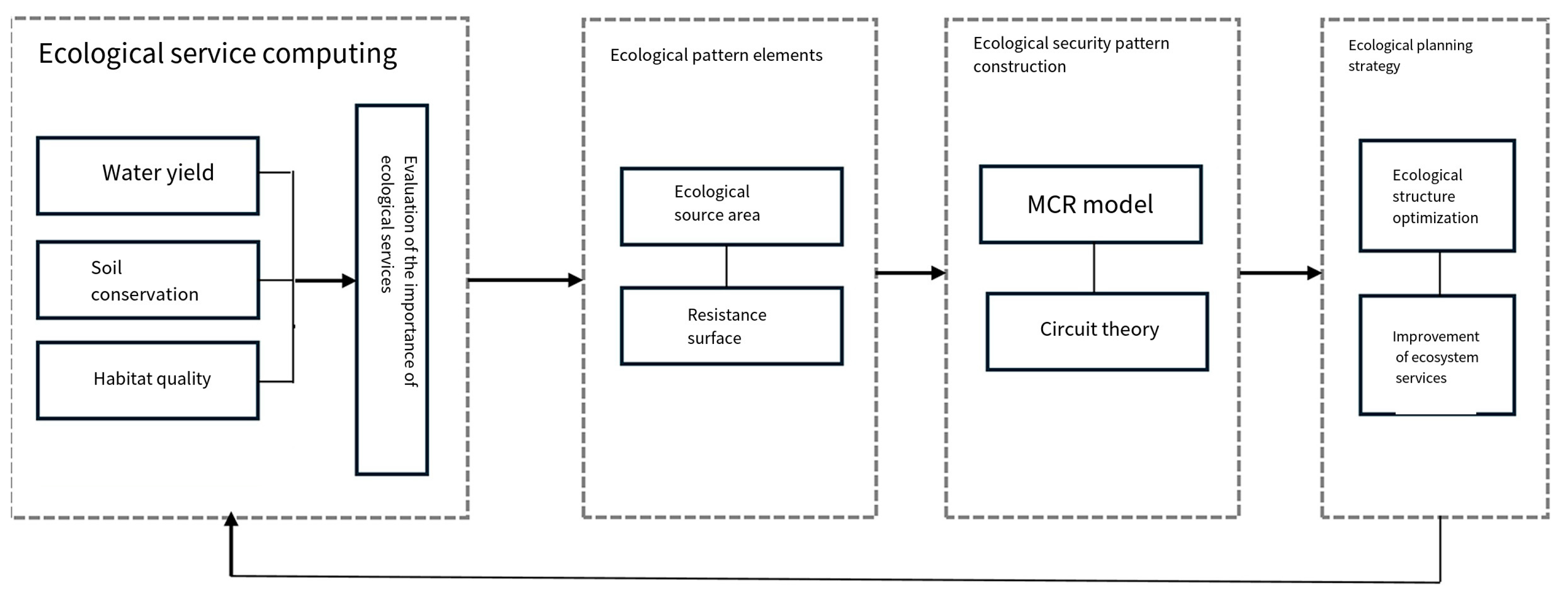
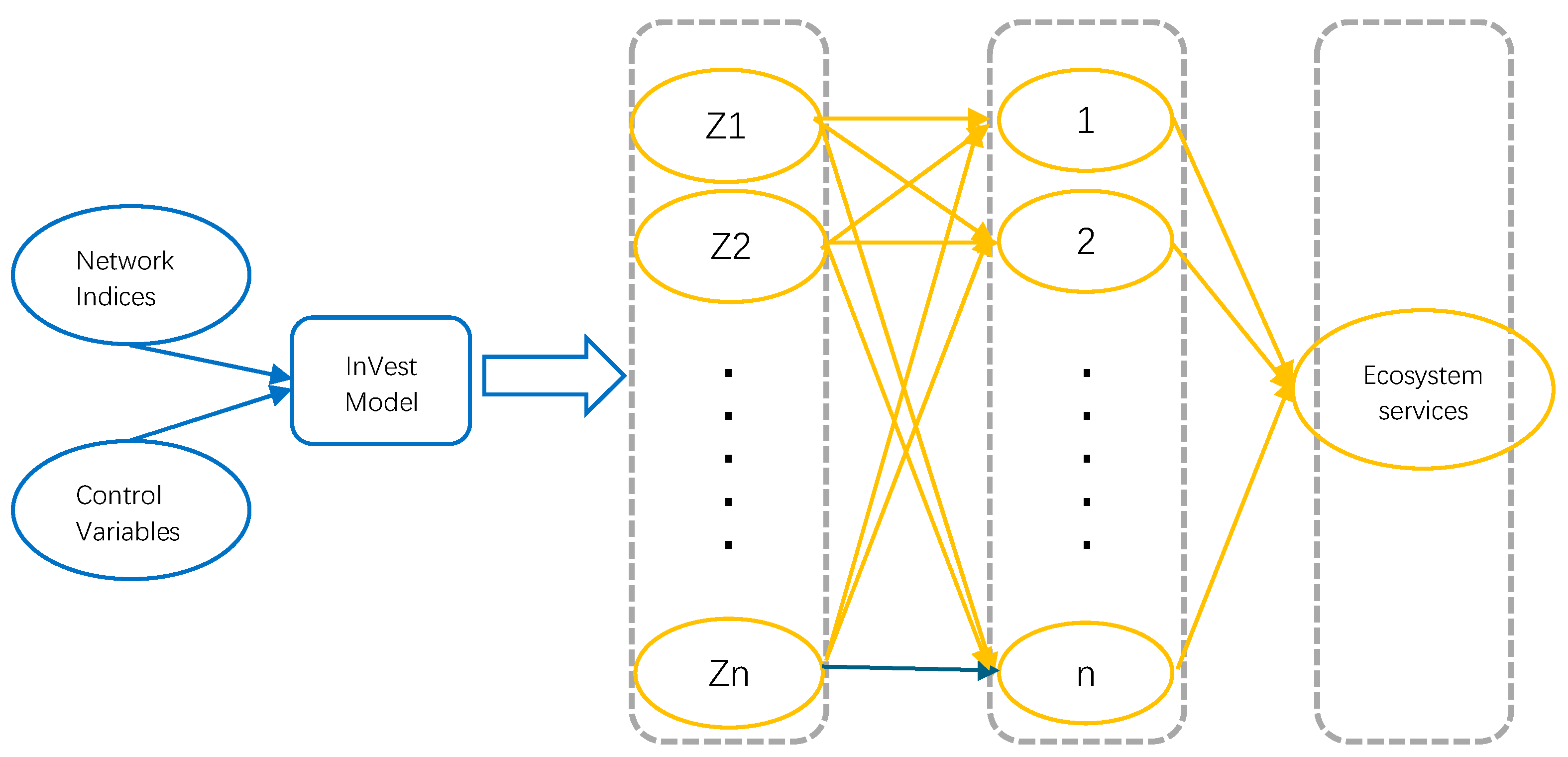
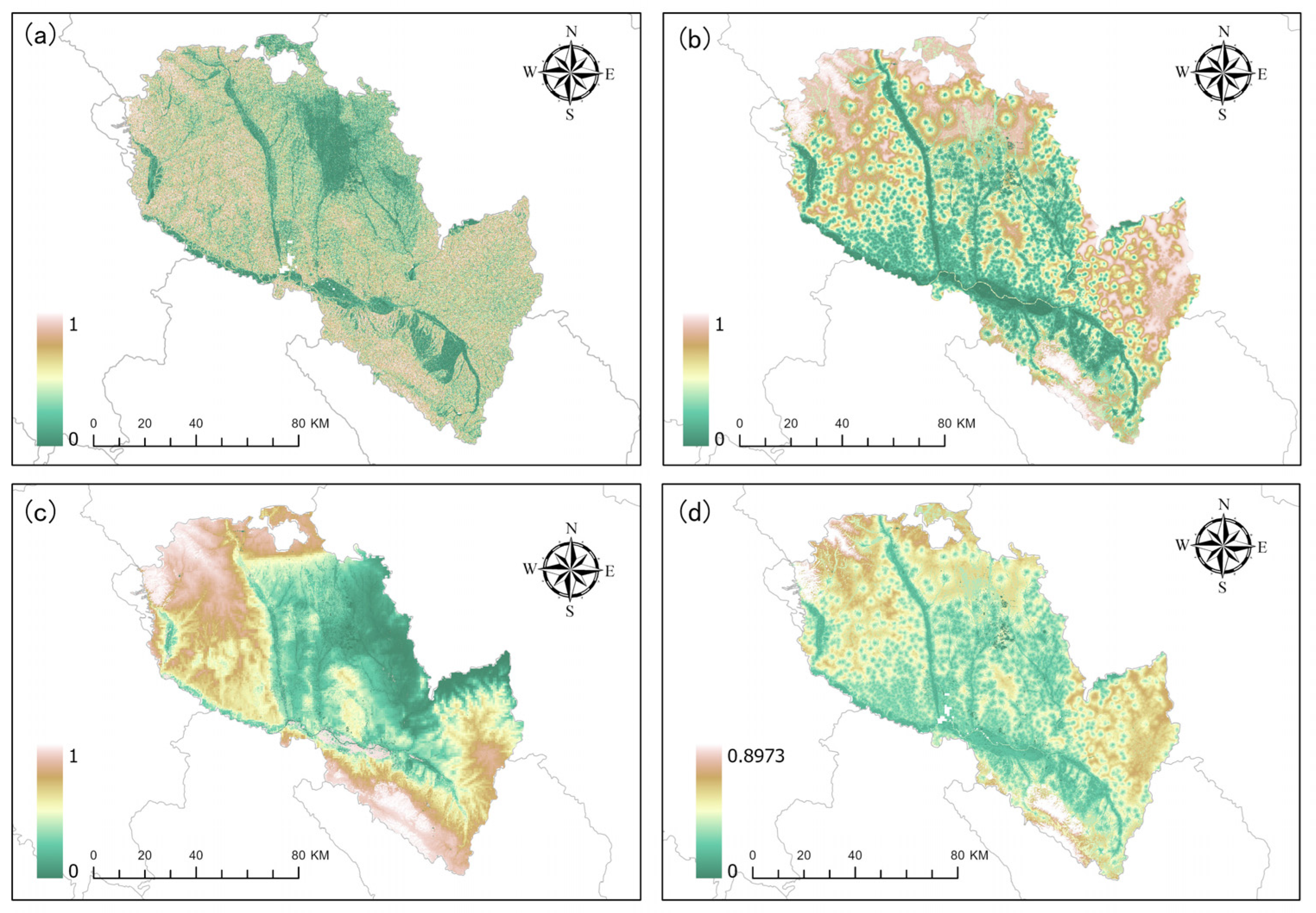
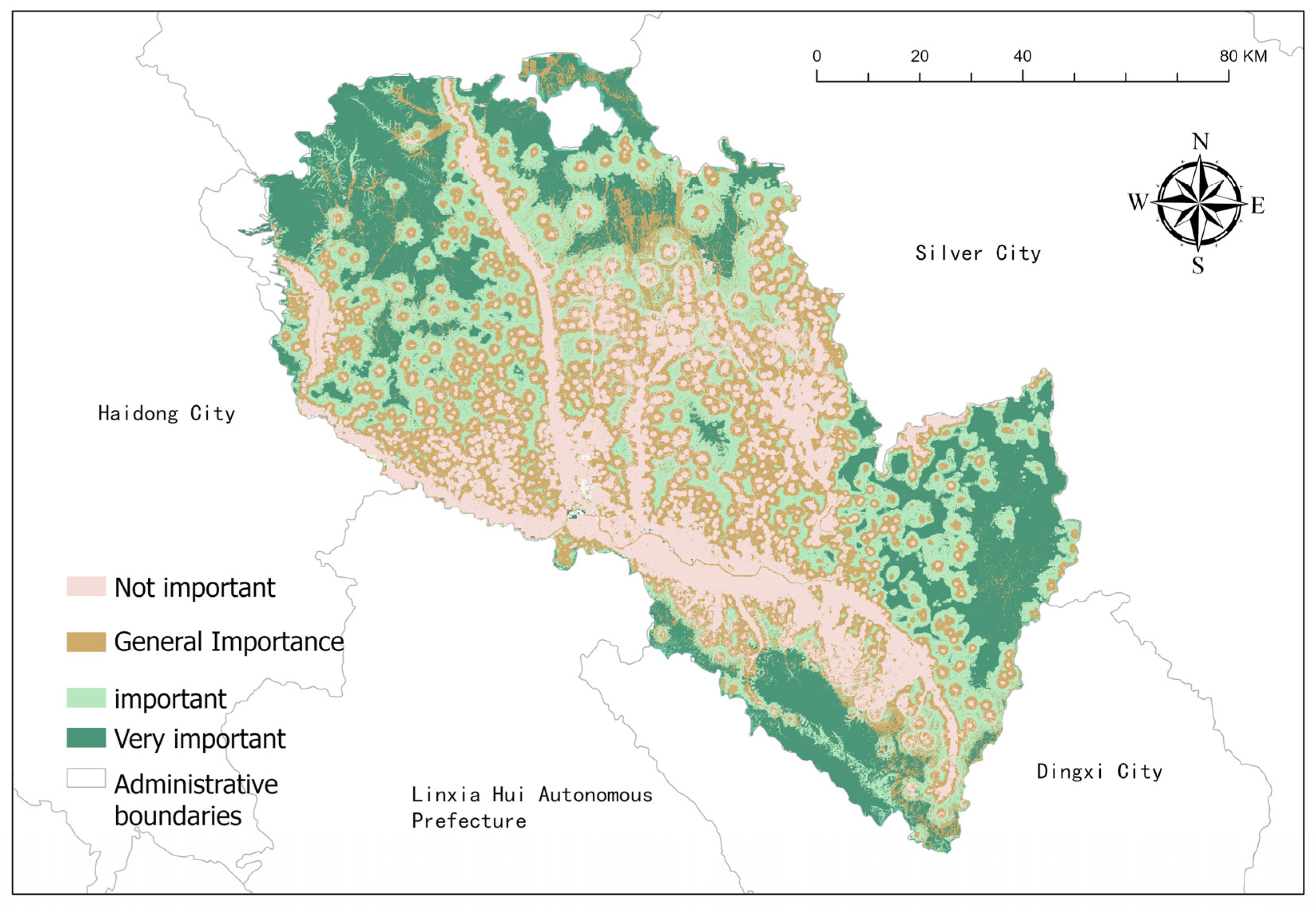
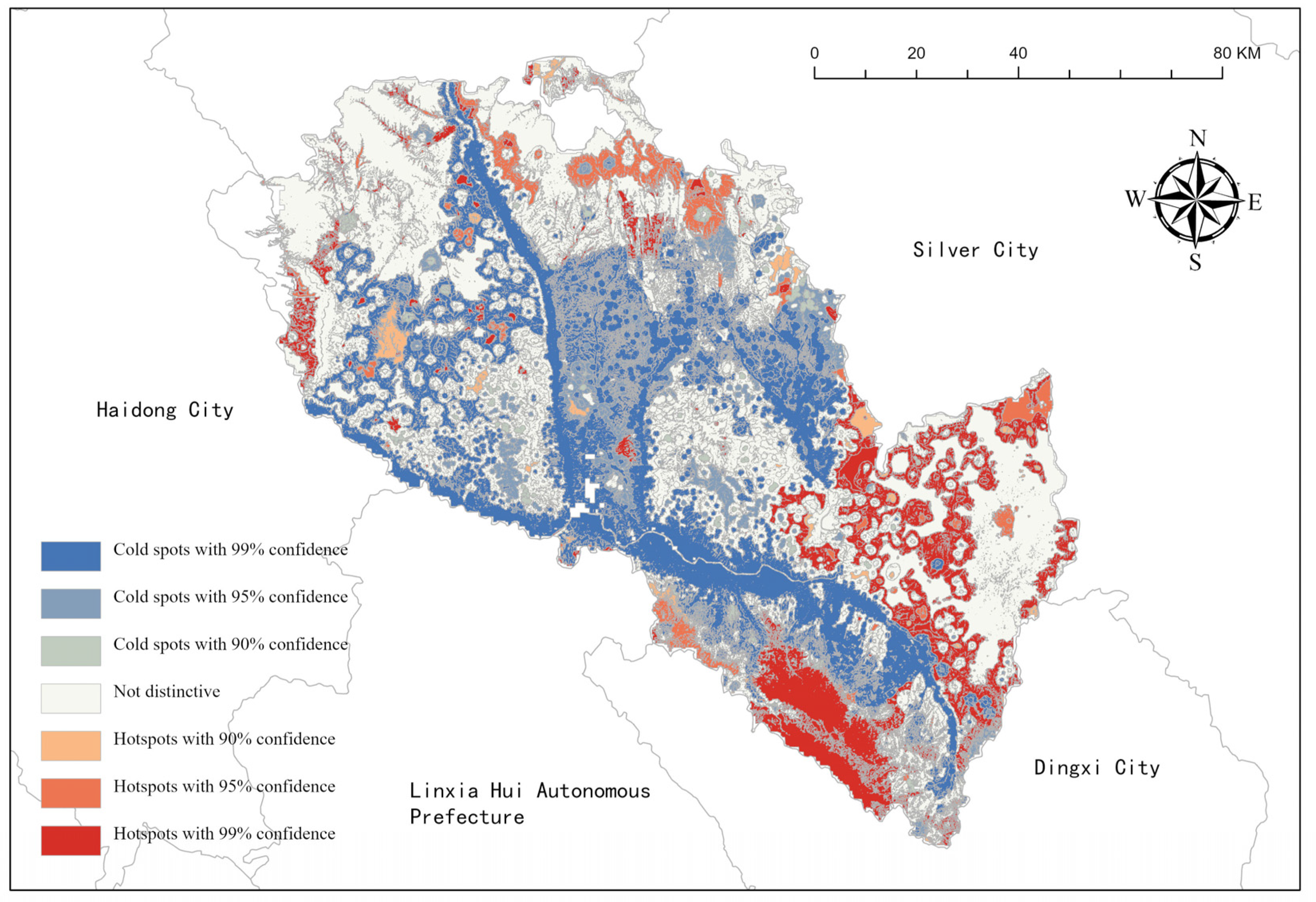
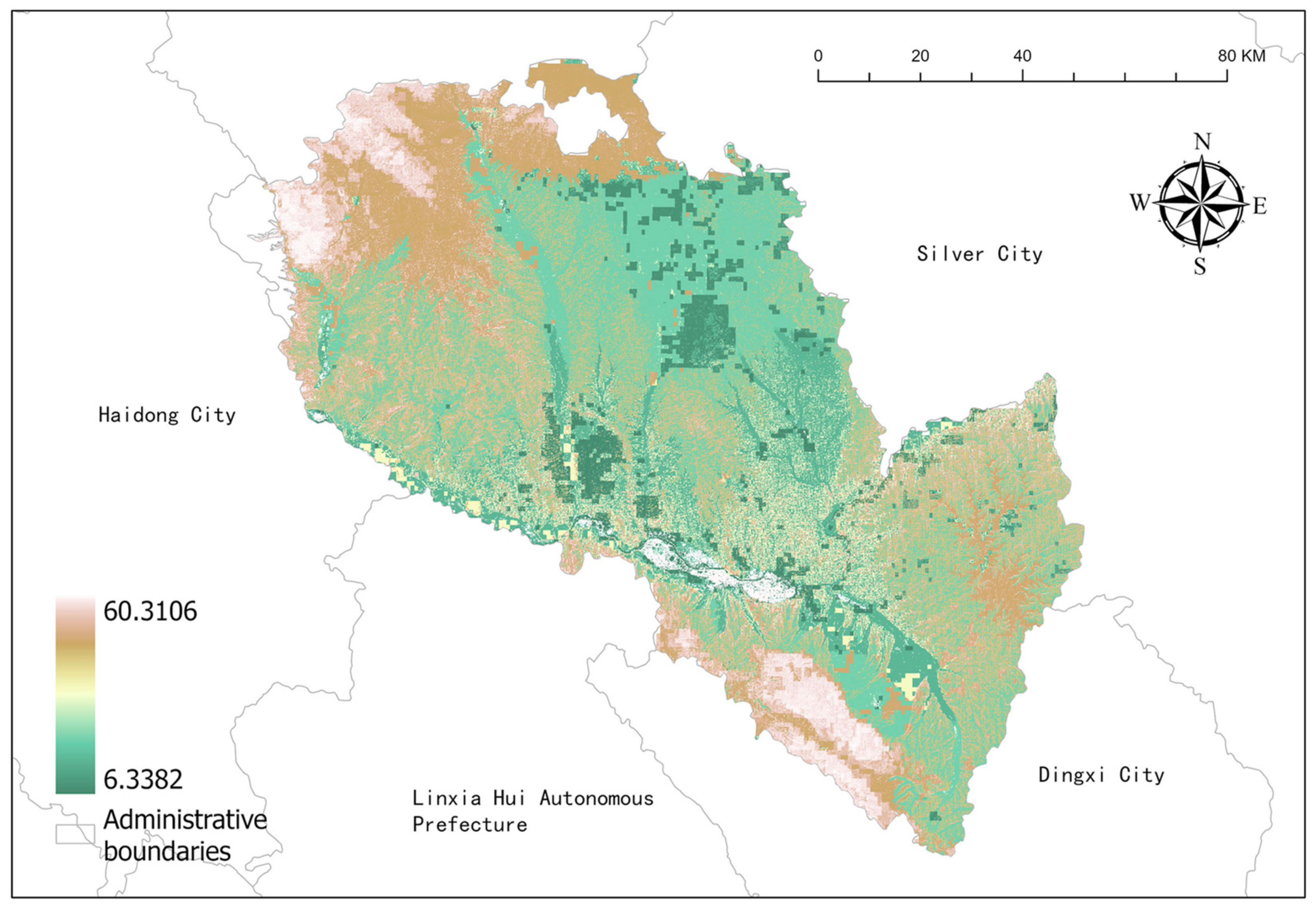
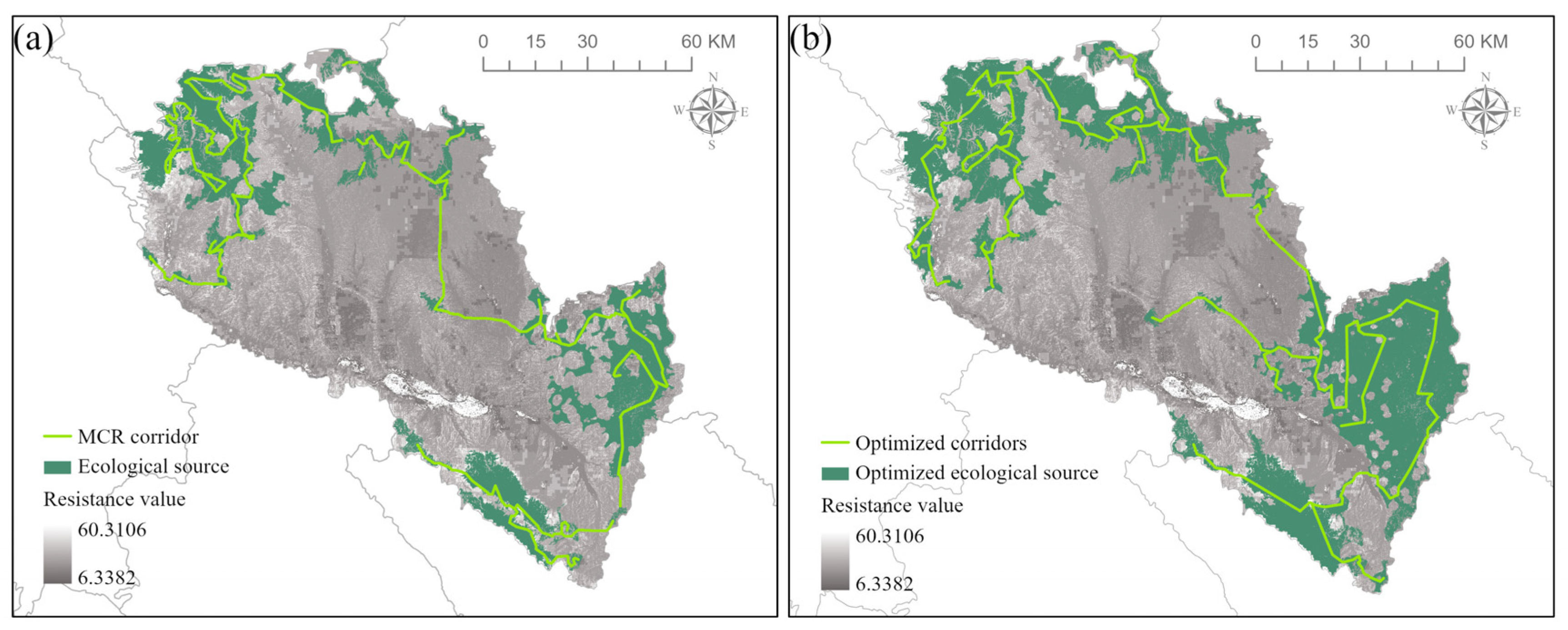


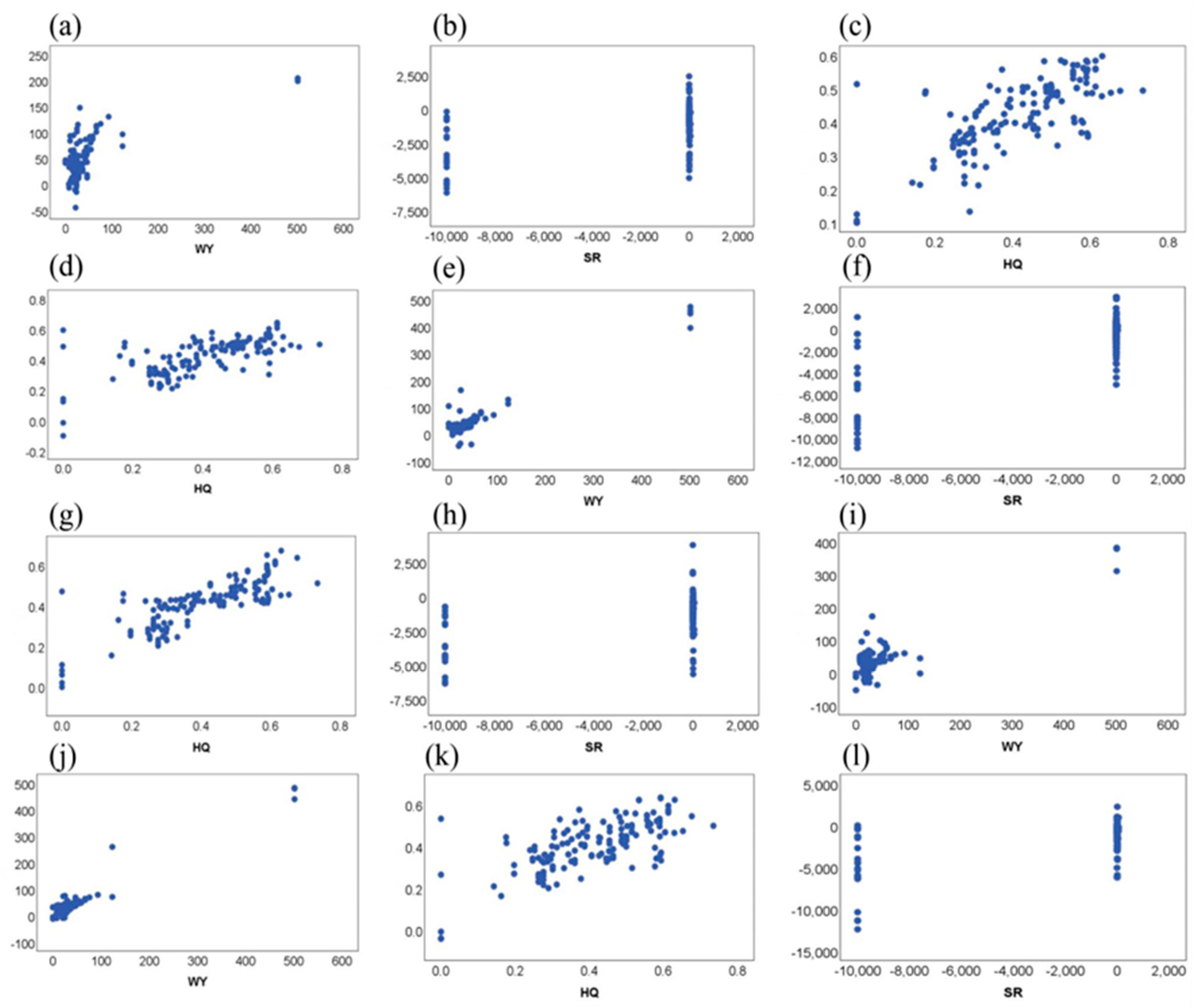
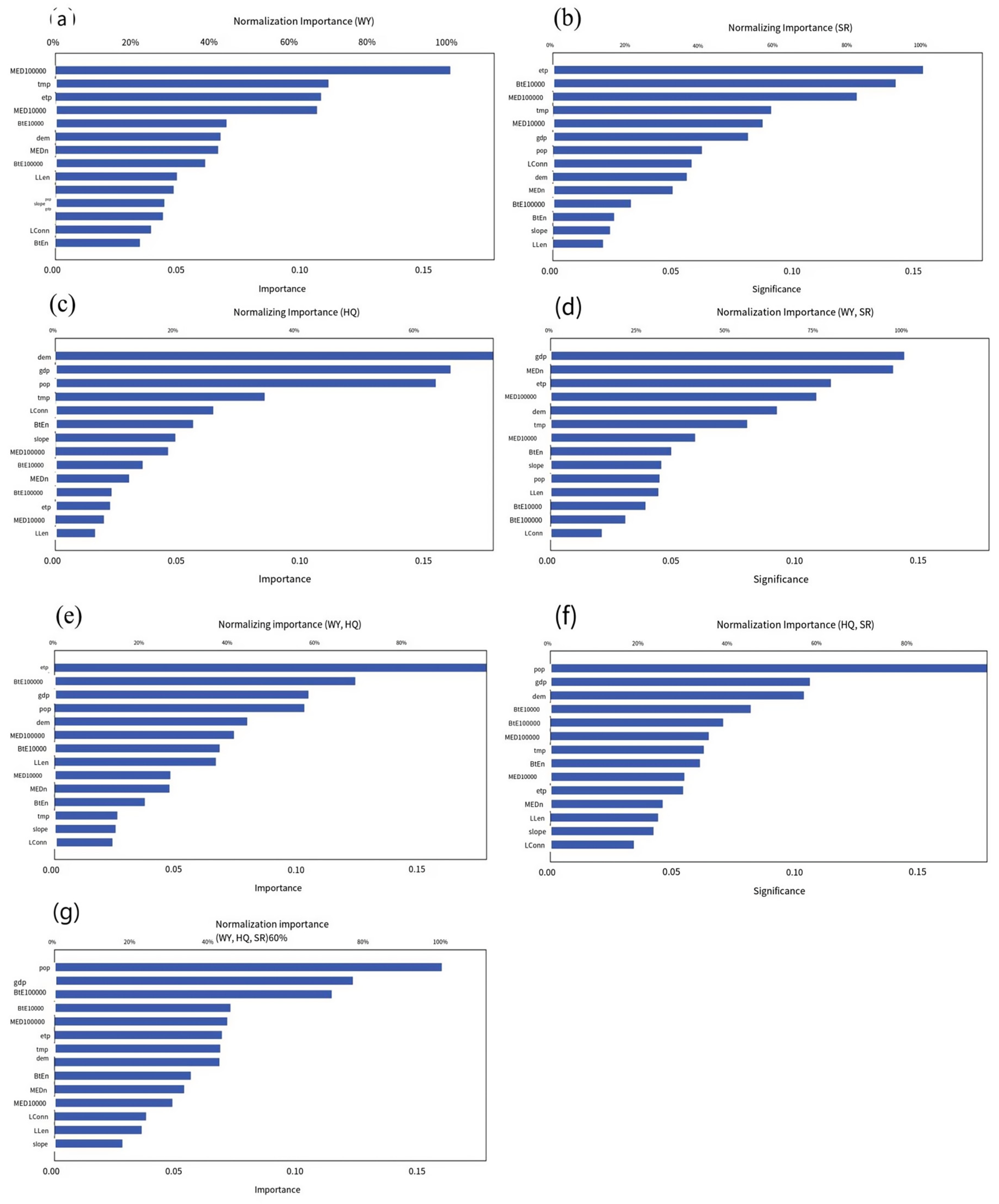
| Dataset Name | Data Source | Indicator Factor |
|---|---|---|
| Administrative division data | Resources and Environmental Science and Data Center | Study area scope |
| Annual 30 m land cover products in China | Professor Huang Xin’s team at Wuhan University, interpreted based on Landsat images | Land use |
| ASTER GDEM v3 | NASA | DEM |
| China’s monthly potential evapotranspiration dataset | National Tibetan Plateau Scientific Data Center | Potential evapotranspiration |
| Chinese Soil Dataset from the World Soil Database (HWSD) (V1.1) | National Tibetan Plateau Scientific Data Center | Organic carbon content |
| Soil organic matter dataset in China | Spatiotemporal three-level environmental big data platform | Organic matter content |
| Monthly precipitation data for China | National Tibetan Plateau Scientific Data Center | Average annual precipitation |
| NDVI data Population raster data GDP data China soil erosion factor K | Resource Environmental Science and Data Center WorldPop Scientific Data National Tibetan Plateau Scientific Data Center | Vegetation Index Population GDP Soil erosion factor K |
| Drag Factor | Weight Value | Drag Coefficient | ||||
|---|---|---|---|---|---|---|
| High | Higher | Equal | Lower | Low | ||
| land use | 0.37006 | 100 | 20 | 15 | 10 | 5 |
| plant | 0.21823 | 100 | 70 | 40 | 20 | 5 |
| dem | 0.14405 | 80 | 60 | 40 | 20 | 5 |
| slope | 0.26765 | 90 | 60 | 40 | 20 | 10 |
| Dependent Variable | R2 | Dependent Variable | R2 | Dependent Variable | R2 | Dependent Variable | R2 |
|---|---|---|---|---|---|---|---|
| Water yield | 0.502 | Water yield, soil conservation, habitat quality | 0.493 (habitat quality) | Habitat quality, water yield | 0.664 (Habitat quality) | Habitat quality, soil conservation | 0.278 (soil conservation) |
| Soil conservation | 0.241 | Water yield, soil conservation, habitat quality | 0.913 (water yield) | Habitat quality, water yield | 0.941 (water yield) | Water yield, soil conservation | 0.796 (water yield) |
| Habitat quality | 0.556 | Water yield, soil conservation, habitat quality | 0.530 (soil conservation) | Habitat quality, soil conservation | 0.523 (Habitat quality) | Water yield, soil conservation | 0.351 (soil conservation) |
Disclaimer/Publisher’s Note: The statements, opinions and data contained in all publications are solely those of the individual author(s) and contributor(s) and not of MDPI and/or the editor(s). MDPI and/or the editor(s) disclaim responsibility for any injury to people or property resulting from any ideas, methods, instructions or products referred to in the content. |
© 2024 by the authors. Licensee MDPI, Basel, Switzerland. This article is an open access article distributed under the terms and conditions of the Creative Commons Attribution (CC BY) license (https://creativecommons.org/licenses/by/4.0/).
Share and Cite
Wang, X.; Tang, X.; Shi, J.; Du, P. Construction and Optimization of Urban and Rural Ecological Security Patterns Based on Ecological Service Importance in a Semi-Arid Region: A Case Study of Lanzhou City. Sustainability 2024, 16, 6177. https://doi.org/10.3390/su16146177
Wang X, Tang X, Shi J, Du P. Construction and Optimization of Urban and Rural Ecological Security Patterns Based on Ecological Service Importance in a Semi-Arid Region: A Case Study of Lanzhou City. Sustainability. 2024; 16(14):6177. https://doi.org/10.3390/su16146177
Chicago/Turabian StyleWang, Xiyun, Xianglong Tang, Jin Shi, and Pengzhen Du. 2024. "Construction and Optimization of Urban and Rural Ecological Security Patterns Based on Ecological Service Importance in a Semi-Arid Region: A Case Study of Lanzhou City" Sustainability 16, no. 14: 6177. https://doi.org/10.3390/su16146177





